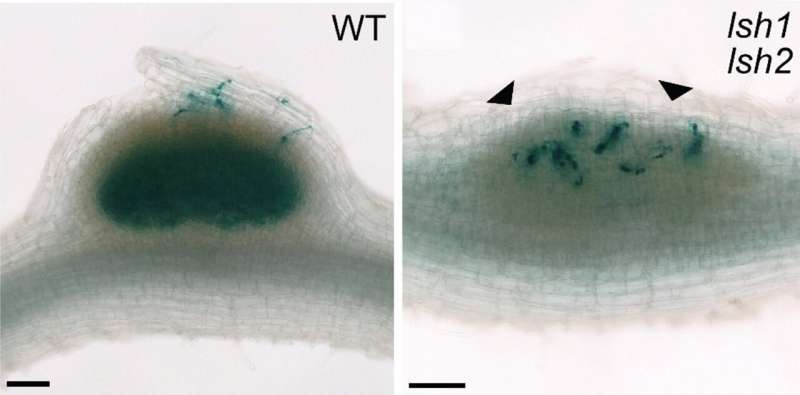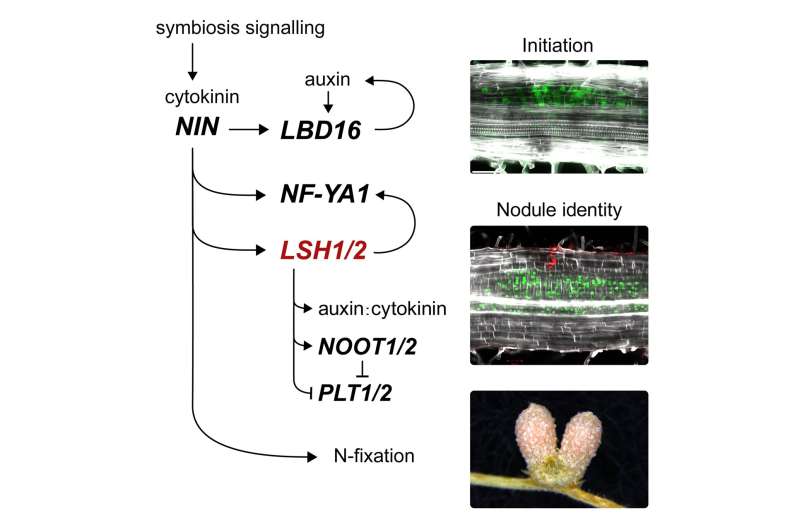This article has been reviewed according to Science X's editorial process and policies. Editors have highlighted the following attributes while ensuring the content's credibility:
fact-checked
trusted source
proofread
LSH genes associated with defining the shapes of stems, flowers and leaves required for N-fixing root nodules

Cambridge scientists have identified two crucial genetic factors needed to produce specialized root organs that can accommodate nitrogen-fixing bacteria in legumes such as peas and beans.
In a surprising twist, the developmental regulators that confer the identity of these organs—known as nodules—belong to a transcription factor family more commonly associated with defining the shapes of stems, flowers and leaves. These factors are broadly conserved in plants, indicating their nodule-specifying function in legumes is a more recent innovation.
This significant discovery brings us one step closer to potentially engineering non-legume cereal crops like wheat, rice and maize to develop root nodule organs to host nitrogen fixing bacteria and reduce our reliance on industrial nitrogen fertilizers produced via the energy-consuming Haber Bosch Process.
This latest research, led by Dr. Katharina Schiessl, a Career Development Fellow at the Sainsbury Laboratory Cambridge University (SLCU), builds on her earlier findings that the same genetic program underlying lateral root development also underpins root nodule initiation.
Dr. Schiessl's discovery takes us a step further along the pathway of understanding how this symbiotic relationship is established between beneficial soil bacteria and legumes and how it is maintained to support biological nitrogen fixation. With the discovery that legumes are recycling genetic programs that are used by many species of plants, including cereals, the engineering task could be a whole lot less complicated.
Published in Current Biology, "Light-sensitive short hypocotyl genes confer symbiotic nodule identity in the legume Medicago truncatula", was a collaboration among scientists working at SLCU, the Crop Science Centre, John Innes Centre, University of Freiburg, Oklahoma State University and Royal Botanic Gardens, Kew.

Their research identified two genetic factors, named LIGHT-SENSITIVE SHORT HYPOCOTYL (LSH1/LSH2), promote the production of specialized root cells that are required to make the developing nodule structure a suitable home for the nitrogen fixing bacteria—conferring nodule organ identity.
"We show two members of the LIGHT SENSITIVE SHORT HYPOCOTYL (LSH) transcription factor family are functioning as regulators of nodule organ identity," Dr. Schiessl said. "LSH1/LSH2 enlist a program in a root tissue called the cortex that facilitates the formation of a group of cells that are infectable and habitable by the bacteria early during nodule development. At the molecular level, this involves inhibiting the default lateral root program, controlling the dynamics of the plant hormones auxin and cytokinin, and promoting the expression of the previously identified key nodule organ identity regulators NODULE ROOT1/2 and Nuclear Factor Y-A1."
In summary, the research shows that root tissues can be reprogrammed by pre-existing shoot programs and includes a proposed model for specification of nodule development: cytokinin activation of NIN expression initiates the nodule primordium through induction of LBD16, which activates local auxin biosynthesis to drive cell divisions in a manner comparable to lateral root initiation. Activation of LSH genes then confers nodule organ identity.
"This finding that legumes are harnessing pre-existing developmental regulators and their associated downstream networks to generate purpose-built organs with novel forms and functions is essential for future engineering of biological nitrogen fixation," Dr. Schiessl said.
Dr. Schiessl's newly formed research group at SLCU is continuing to explore the regulatory pathways and cellular processes of colonizer-induced organ development, studying symbiotic root nodules and parasitic galls.

Conferring symbiotic root nodule organ identity
The accommodation of nitrogen fixing bacteria is endosymbiotic, inside specialized cells in the root nodule and requires three key processes: 1) the recognition of the bacteria as friends, 2) their friendly invasion via an infection thread stretching from the root hair to the inner tissue layers of the root, and 3) the accommodation of the nitrogen fixing bacteria inside vesicles of specialized cells in the nodule.
The symbiotic interaction starts with an exchange of sophisticated signals that permit the friendly invasion by the bacteria via the root hair and into the inner tissue layers where the bacteria meet the group of newly divided cells that have specialized to take up the bacteria inside of vesicles with suitable conditions for biological nitrogen fixation—the conversion of nitrogen in the air to ammonia, a plant available form of nitrogen.
While symbiotic root nodules are specialized structures that are induced in response to nitrogen fixing soil bacteria in the roots of legumes, the researchers found a re-networking of pre-existing developmental pathways with conserved functions observed in above-ground shoot organs of both legume and non-legume plants was involved in conferring root nodule identity.
This is similar to Dr. Schiessl's earlier research, which found that plants recycle a genetic program used in initiating lateral roots to also initiate root nodules. This new research identified that the LSH1/LSH2 genetic program, which is recognized as being involved in shoot meristems and organ boundaries in leaves and flowers, was being recruited in roots to confer nodule identity.
The researchers confirmed that LSH genes function as key regulators and integrators of nodule organ identity and differentiate nodules from lateral roots on top of the shared lateral-root like initiation program.
"We have shown that LSHs directly promote cell divisions in the root cortex that support bacterial colonization and promote expression of the previously identified and well-known nodule organ identity genes NOOT1/NOOT2 and NF-YA1," Dr. Schiessl said.
More information: Tak Lee et al, Light-sensitive short hypocotyl genes confer symbiotic nodule identity in the legume Medicago truncatula, Current Biology (2024). DOI: 10.1016/j.cub.2024.01.018
Provided by University of Cambridge




















